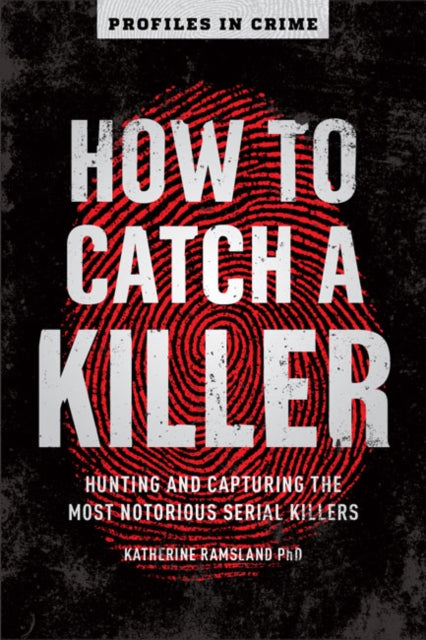Katherine Ramsland
How to Catch a Killer: Hunting and Capturing the World's Most Notorious Serial Killers
How to Catch a Killer: Hunting and Capturing the World's Most Notorious Serial Killers
YOU SAVE £4.29
- Condition: Brand new
- UK Delivery times: Usually arrives within 2 - 3 working days
- UK Shipping: Fee starts at £2.39. Subject to product weight & dimension
Bulk ordering. Want 15 or more copies? Get a personalised quote and bigger discounts. Learn more about bulk orders.
Couldn't load pickup availability
- More about How to Catch a Killer: Hunting and Capturing the World's Most Notorious Serial Killers
This book explores the evolution of forensic techniques used to catch serial killers, including the use of laser ablation, video spectral analysis, cyber-sleuthing, and DNA-based genetic genealogy. It highlights the stories of notorious serial killers such as Rodney Alcala, Takahiro Shiraishi, Aileen Wuornos, Jeffrey Dahmer, Bobby Joe Long, Ted Bundy, and David Berkowitz, and how these techniques helped identify and apprehend them.
Format: Paperback / softback
Length: 320 pages
Publication date: 07 September 2020
Publisher: Sterling Publishing Co Inc
The pursuit and capture of serial killers is a complex and multifaceted endeavor that involves a myriad of factors, from the killer's modus operandi to the skill and dedication of law enforcement personnel. In this book, we delve into the second part of the crime story, exploring how the process of profiling, hunting, and apprehending these predators has evolved over time, particularly in the field of criminal forensics.
Forensic science has played a pivotal role in the pursuit of serial killers, with advancements in technology and techniques leading to more accurate identification and prosecution. Laser ablation, video spectral analysis, cyber-sleuthing, and even DNA-based genetic genealogy are now crucial tools in solving murders, including the recent capture of the so-called Golden State Killer.
The killers featured in this book are some of the most notorious serial killers in history, each with their unique methods and motives. Rodney Alcala, a serial rapist and murderer sometimes called the "Dating Game killer" for his appearance on that TV show, is believed to have victimized hundreds of people, but the exact number remains unknown. Takahiro Shiraishi, a suicide killer from Zama, Japan, dismembered nine victims and stored their bodies in his refrigerator. Aileen Wuornos, one of the rare female serial killers, shot seven men in Florida and was turned in by an accomplice. Jeffrey Dahmer, the "Milwaukee Cannibal," and Bobby Joe Long, both identified by survivors, made mistakes that ultimately led to their capture.
Ludwig Tessnow, who killed several children in Germany, and was caught through new methods in forensic investigation that could distinguish human from animal blood, is another example of how forensic science has advanced.
The process of profiling and hunting serial killers is a complex and challenging one, requiring a deep understanding of the killer's behavior and motives. It involves a combination of scientific analysis, psychological profiling, and traditional investigative techniques. Investigators must be able to gather evidence, track down leads, and build a case against the killer, often facing obstacles and challenges along the way.
One of the key challenges in profiling and hunting serial killers is the lack of reliable information and witnesses. Many killers are able to evade capture for years, often leaving behind a trail of victims and clues that can be difficult to piece together. Additionally, serial killers can be highly manipulative and skilled at eluding detection, making it essential for law enforcement personnel to be vigilant and persistent in their pursuit.
Despite these challenges, the capture of serial killers has led to significant advancements in the field of criminal forensics and has helped to protect communities from these dangerous predators. The stories of these killers and the efforts of law enforcement personnel to bring them to justice serve as a reminder of the importance of collaboration, dedication, and innovation in the fight against crime.
In conclusion, the pursuit and capture of serial killers is a complex and multifaceted endeavor that requires a combination of scientific analysis, psychological profiling, and traditional investigative techniques. Forensic science has played a pivotal role in this process, with advancements in technology and techniques leading to more accurate identification and prosecution. The stories of these killers and the efforts of law enforcement personnel to bring them to justice serve as a reminder of the importance of collaboration, dedication, and innovation in the fight against crime.
Weight: 400g
Dimension: 141 x 209 x 28 (mm)
ISBN-13: 9781454939375
This item can be found in:
UK and International shipping information
UK and International shipping information
UK Delivery and returns information:
- Delivery within 2 - 3 days when ordering in the UK.
- Shipping fee for UK customers from £2.39. Fully tracked shipping service available.
- Returns policy: Return within 30 days of receipt for full refund.
International deliveries:
Shulph Ink now ships to Australia, Belgium, Canada, France, Germany, Ireland, Italy, India, Luxembourg Saudi Arabia, Singapore, Spain, Netherlands, New Zealand, United Arab Emirates, United States of America.
- Delivery times: within 5 - 10 days for international orders.
- Shipping fee: charges vary for overseas orders. Only tracked services are available for most international orders. Some countries have untracked shipping options.
- Customs charges: If ordering to addresses outside the United Kingdom, you may or may not incur additional customs and duties fees during local delivery.


